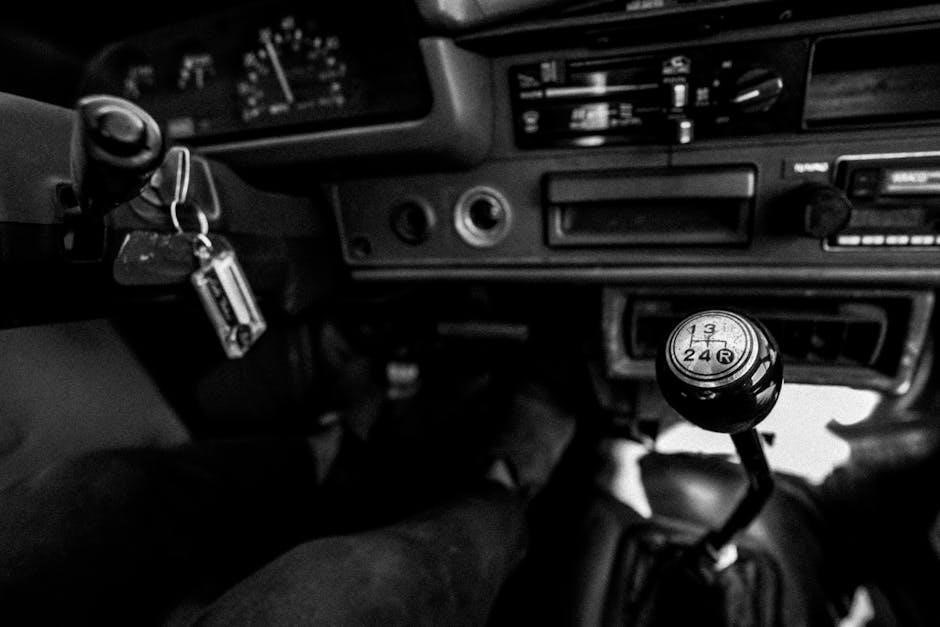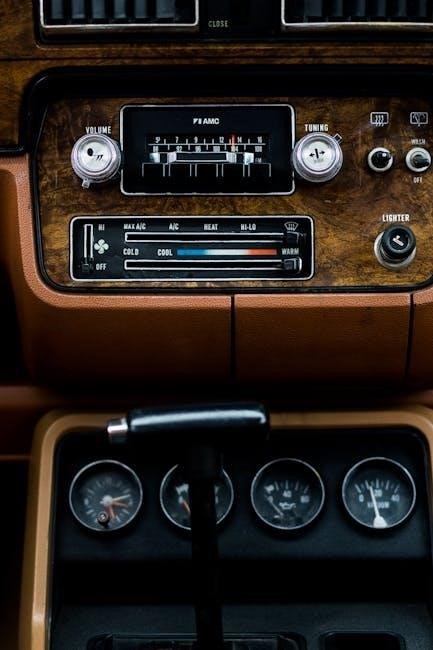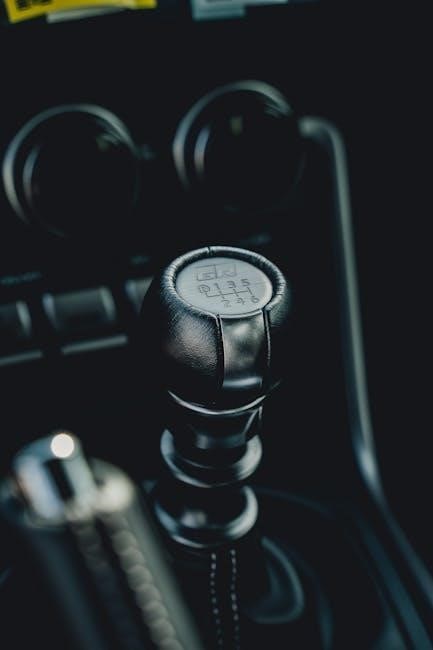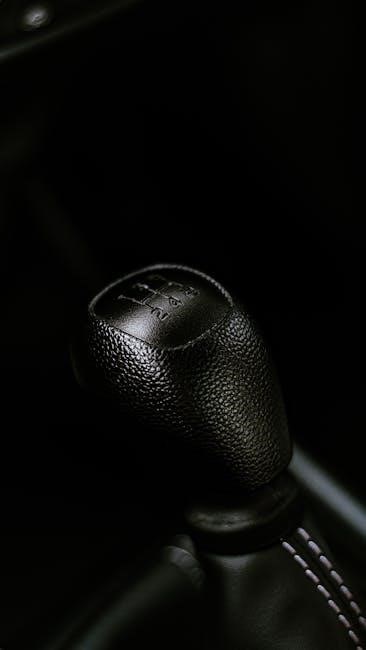The Camaro transmission manual is an essential guide for understanding and maintaining your vehicle’s gearbox. It covers automatic and manual transmissions, offering insights into proper maintenance, troubleshooting, and optimal performance.
1.1 What is a Transmission Manual?
A transmission manual is a comprehensive guide detailing the components, functions, and maintenance of a vehicle’s gearbox. It provides detailed instructions for operation, troubleshooting, and repair, ensuring optimal performance and longevity of the transmission system. The manual typically includes diagrams, specifications, and step-by-step procedures tailored to specific models, such as the Camaro. It serves as an essential resource for drivers and mechanics, helping them understand and address transmission-related issues effectively.
1.2 Importance of Understanding the Transmission Manual
Understanding the transmission manual is crucial for optimal vehicle performance and longevity. It helps drivers identify potential issues early, perform routine maintenance, and make informed decisions about repairs. Proper knowledge reduces the risk of transmission damage, saving time and money. The manual provides insights into fluid levels, filter replacements, and shifting techniques, ensuring smooth operation. For Camaro owners, this understanding enhances driving efficiency and extends the lifespan of the transmission system, making it a valuable resource for both novices and experienced enthusiasts.
1.3 Brief Overview of the Camaro Transmission System
The Camaro transmission system is designed for high performance, offering both automatic and manual options. It features a gearbox with synchronized gears, a clutch system for manual models, and advanced fluid systems to ensure smooth operation. The transmission is integrated with the engine to deliver power efficiently, providing a responsive driving experience. Regular maintenance, such as fluid replacements and filter checks, is essential to maintain its performance and durability. This system is a key component in the Camaro’s reputation for speed and reliability on the road.

Types of Transmissions in Camaro
Camaro offers two primary transmission types: automatic and manual. Each provides unique benefits, catering to different driving preferences and performance needs, ensuring optimal efficiency.

2.1 Automatic Transmission
The Camaro’s automatic transmission offers seamless shifting and effortless driving. It uses a torque converter to transfer power and features planetary gears for smooth acceleration. Modern models include advanced electronic controls for optimal performance and fuel efficiency. This system is ideal for drivers seeking convenience and a relaxed driving experience, especially in city traffic. The automatic transmission also provides consistent power delivery, making it suitable for both daily commuting and spirited driving on the highway.
2.2 Manual Transmission
The Camaro’s manual transmission offers a driver-centric experience, providing precise control over gear shifts. It features a clutch pedal and a gearshift, enabling enthusiasts to connect with the vehicle’s performance. Manual transmissions typically offer better fuel efficiency and a more engaging driving experience. The system requires coordination between the clutch and accelerator for smooth shifting. This setup is ideal for drivers who enjoy spirited driving and the tactile feedback of manual gear changes, making it a popular choice for performance-oriented enthusiasts.
2.3 Pros and Cons of Each Type
Automatic transmissions offer convenience and ease of use, ideal for city driving and smooth acceleration. They reduce driver fatigue but may lack the direct control of manual transmissions. Manual transmissions provide better fuel efficiency, lower costs, and a more engaging driving experience. However, they require more skill and can be less convenient in heavy traffic. Choosing between the two depends on personal preference, driving habits, and performance needs. Balancing these factors helps determine the best option for a seamless and enjoyable driving experience.

Components of the Camaro Manual Transmission
The Camaro manual transmission includes essential components like the gearbox, clutch system, transmission fluid, and shift mechanism, each playing a vital role in smooth gear operation.
3.1 Gearbox and Gears
The gearbox in the Camaro manual transmission houses the gears responsible for transferring power from the engine to the wheels. It consists of a set of precisely engineered gears, including input, output, and idler gears, which work harmoniously to provide smooth and efficient gear transitions. The gearbox is designed to withstand high torque and stress, ensuring durability and performance. Synchronizers are also integrated to facilitate seamless shifting between gears, reducing wear and tear. Proper lubrication and alignment are critical for optimal functionality and longevity of the gearbox and gears.
3.2 Clutch System
The clutch system in the Camaro manual transmission is essential for disconnecting and reconnecting power from the engine to the gearbox. It consists of a clutch pedal, master cylinder, slave cylinder, and a clutch disc. When the pedal is pressed, it disengages the clutch, allowing smooth gear shifts without grinding. The clutch disc, made of durable friction material, ensures proper power transfer. Proper clutch engagement is critical to avoid wear and premature failure. Regular inspection and maintenance, such as fluid checks, are vital to ensure the clutch system operates efficiently and reliably over time.
3.3 Transmission Fluid and Filter
Transmission fluid is crucial for lubricating the Camaro’s manual transmission, ensuring smooth gear operation and preventing overheating. The filter cleans the fluid, removing contaminants that could damage components. Regular fluid checks are recommended, with replacement typically every 30,000 to 60,000 miles. Using the correct type of fluid, as specified in the owner’s manual, is essential for optimal performance. A dirty or clogged filter can lead to poor shifting and increased wear, so it should be replaced during fluid changes to maintain transmission health and reliability over time.
3.4 Shift Mechanism
The shift mechanism in the Camaro’s manual transmission connects the gear shifter to the transmission, enabling precise gear selection. It includes the shifter, linkage, and cables, which work together to engage gears smoothly. Proper alignment and lubrication are essential for optimal performance. Over time, wear on the linkage or cables can cause vague shifting or difficulty engaging gears. Regular inspection and adjustment of the shift mechanism ensure crisp, responsive shifts, enhancing the driving experience and maintaining transmission longevity. Always refer to the manual for specific adjustment procedures.

How to Use the Camaro Manual Transmission
Mastering the Camaro’s manual transmission involves coordinating clutch and accelerator pedals for smooth shifts. Use the gear shifter to select the appropriate gear for speed and terrain. Proper technique ensures ease of control and a responsive driving experience.
4.1 Basic Shifting Techniques
Mastering basic shifting techniques is essential for smooth and efficient driving. Start by fully pressing the clutch pedal with your foot to disengage the engine from the transmission. Use the gear shifter to select the desired gear, ensuring it clicks into place. Slowly release the clutch while simultaneously pressing the accelerator to maintain control. Always match your gear selection to your speed and driving conditions for optimal performance. Practice shifting in a safe, open area to build muscle memory and confidence behind the wheel.
4.2 Accelerating and Decelerating
When accelerating, ensure smooth transitions by selecting the appropriate gear for your speed and driving conditions. Avoid riding the clutch, as this can cause unnecessary wear. Downshift before braking to maintain control and use engine braking to reduce strain on the brakes. During acceleration, shift gears at the optimal RPM range to maximize power delivery. Monitor your RPMs to avoid over-revving or lugging the engine. Smooth, gradual acceleration and deceleration will enhance performance and extend the life of your Camaro’s manual transmission.
4.3 Proper Clutch Engagement
Proper clutch engagement is essential for smooth shifting in the Camaro manual transmission. Press the clutch pedal fully down before shifting gears to ensure disengagement. Gradually release the clutch while pressing the accelerator to avoid jerking. Avoid “riding the clutch,” as this can wear out the clutch assembly. When engaging the clutch, feel for the “bite point” where the engine begins to connect with the transmission. Smooth, deliberate movements ensure proper engagement and extend the life of the clutch system.

Maintenance and Service of the Camaro Transmission
Regular maintenance ensures optimal performance and longevity of the Camaro transmission. Schedule fluid changes, inspect for leaks, and replace worn components promptly to prevent major issues.
5.1 Recommended Service Intervals
Regular servicing is crucial for maintaining the Camaro transmission’s health; Typically, transmission fluid should be replaced every 30,000 to 60,000 miles, depending on driving conditions. Severe driving, such as frequent stop-and-go traffic or towing, may require more frequent maintenance. Additionally, the transmission filter should be inspected and cleaned or replaced during these intervals. Adhering to the manufacturer’s recommended schedule ensures smooth operation, prevents wear, and extends the lifespan of the transmission system.
5.2 Transmission Fluid Replacement
Transmission fluid replacement is essential for maintaining optimal performance. Over time, the fluid degrades, reducing its ability to lubricate and cool the system. For the Camaro, it’s recommended to replace the fluid every 30,000 to 60,000 miles, depending on driving conditions. Always use the manufacturer-recommended fluid type to ensure compatibility. Draining the old fluid, replacing the filter, and refilling with fresh fluid are standard steps. Synthetic fluids are preferred for better performance and longevity. Avoid mixing fluid types to prevent damage. Consult a professional if unsure about the process.
5.3 Filter Cleaning or Replacement
Regular maintenance of the transmission filter is crucial for ensuring smooth operation. The filter prevents debris from entering the transmission system, safeguarding internal components from damage. It’s recommended to clean or replace the filter every 30,000 to 60,000 miles, depending on usage. Cleaning involves removing and inspecting the filter, then rinsing it with a solvent. If damaged, replacement is necessary. Always use a torque wrench when reinstalling to avoid over-tightening. Proper filter maintenance enhances transmission efficiency and longevity. Consult a professional if unsure about the process to avoid potential damage.

Common Issues with the Camaro Manual Transmission
Common issues with the Camaro manual transmission include wear on components, improper driving habits, and lack of maintenance, leading to operational problems and requiring timely attention.
6.1 Grinding or Scraping Noises
Grinding or scraping noises in the Camaro manual transmission often indicate worn-out components such as the clutch disc, pressure plate, or flywheel. These sounds typically occur during gear shifts or when engaging the clutch. Improper clutch engagement, such as riding the clutch or sudden disengagement, can exacerbate wear. Additionally, misaligned gears or excessive wear on synchronizers may also produce grinding noises. It is crucial to inspect these components promptly to prevent further damage to the transmission system. Regular maintenance and proper driving habits can help minimize such issues.
6.2 Difficulty Shifting Gears
Difficulty shifting gears in the Camaro manual transmission can stem from issues like a worn-out clutch, low transmission fluid levels, or misaligned gear components. If the clutch isn’t engaging smoothly, gears may resist shifting, especially when accelerating or decelerating. Additionally, worn-out synchronizers or damaged gear teeth can cause hesitation or refusal to shift; Addressing these problems early is essential to prevent further damage to the transmission system. Regular maintenance, such as checking fluid levels and inspecting components, can help ensure smooth gear transitions and optimal performance.
6.3 Leaks and Fluid Loss
Leaks and fluid loss in the Camaro’s manual transmission can lead to serious damage if not addressed promptly. Transmission fluid is essential for lubrication and cooling, so any leakage can cause increased temperatures and wear on components. Common causes include worn-out seals, gaskets, or cracks in the transmission pan. Symptoms may include visible fluid spots underneath the vehicle, low fluid levels, or increased engine temperature. Regular inspections can help identify these issues early, and prompt repairs are necessary to maintain optimal performance, prevent further complications, and ensure the longevity and reliability of the transmission system.

Troubleshooting the Camaro Transmission
Troubleshooting the Camaro transmission involves identifying symptoms, using diagnostic tools, and applying targeted repairs. Regular checks and professional assistance ensure optimal performance and prevent major issues.
7.1 Identifying Symptoms

Identifying symptoms of Camaro transmission issues is crucial for early detection. Common signs include slipping gears, delayed engagement, unusual noises like grinding or whining, and warning lights on the dashboard. Performance issues, such as hesitation or jerking during acceleration, may also indicate problems. Additionally, transmission fluid leaks or unusual vibrations can signal underlying concerns. Recognizing these symptoms early helps prevent minor issues from escalating into major repairs. Always consult the owner’s manual or a certified mechanic for accurate diagnosis and appropriate solutions.
7.2 Diagnostic Tools and Methods
Diagnostic tools and methods for the Camaro transmission include the use of an OBD-II scanner to read error codes stored in the vehicle’s computer. Pressure testing can identify issues within the hydraulic system, while a scan tool provides real-time data on transmission performance. Visual inspections of the transmission pan, fluid condition, and wiring are also critical. Additionally, test drives can reveal specific symptoms under various driving conditions. These tools help pinpoint problems accurately, ensuring effective troubleshooting and repair.
7.3 Common Repair Solutions
Common repair solutions for the Camaro manual transmission include replacing worn clutch components, sealing leaks, or rebuilding the gearbox. Damaged gears or bearings are typically replaced with OEM or aftermarket parts. Faulty shift linkages or cables are adjusted or replaced to restore smooth shifting. In severe cases, a full transmission rebuild may be necessary. Regular fluid changes and filter replacements can prevent premature wear. Addressing issues early ensures optimal performance and avoids costly repairs down the road.

Upgrading the Camaro Transmission
Upgrading the Camaro transmission enhances performance, durability, and drivability, especially for high-performance or racing applications. It involves replacing or modifying components to handle increased power and torque.
8.1 Why Upgrade the Transmission?
Upgrading the Camaro transmission is essential for drivers seeking enhanced performance, especially in high-performance or racing scenarios. It ensures the system can handle increased power and torque without failure. A upgraded transmission improves acceleration, reduces wear, and minimizes the risk of overheating during aggressive driving. For drivers modifications like engine upgrades, a stronger transmission is crucial to maintain reliability and responsiveness. Upgrading also enhances the overall driving experience, offering smoother shifts and better control, making it a worthwhile investment for enthusiasts.
8.2 Available Upgrade Options
Several upgrade options are available for enhancing the Camaro transmission. These include performance clutches for better power handling, heavy-duty gear sets for increased durability, and aftermarket shift kits for smoother shifting. Additionally, high-performance transmission coolers can be installed to prevent overheating during aggressive driving. Enhanced torque converters are another option, improving acceleration and responsiveness. Custom-built transmissions tailored to specific driving needs are also available, offering superior strength and reliability for high-performance applications. These upgrades ensure optimal performance and longevity for demanding driving conditions.
8.3 Installation Considerations
Installing upgraded transmission components requires careful planning and expertise. Ensure proper alignment of gears and components to avoid damage. Use specialized tools for torque converters and clutch systems. A well-equipped workspace and mechanical expertise are essential for precise installation. Follow manufacturer guidelines for bolt torque specifications and fluid levels. Test the system thoroughly after installation to ensure smooth operation. Consider professional help if unfamiliar with complex procedures to avoid costly mistakes and ensure reliability.
Understanding and maintaining your Camaro’s transmission is key for performance and longevity. Regular maintenance and addressing issues promptly ensure a smooth experience. This guide helps maximize efficiency and durability, ensuring a reliable vehicle for years.
9.1 Summary of Key Points
The Camaro transmission manual provides essential insights into understanding, maintaining, and troubleshooting its transmission system. It covers automatic and manual transmissions, highlighting their pros and cons. Regular maintenance, including fluid replacement and filter cleaning, is crucial for longevity. Troubleshooting common issues like grinding noises or shifting difficulties helps prevent major repairs. Upgrading the transmission can enhance performance, but careful planning is needed. By following this guide, drivers can optimize their Camaro’s transmission for reliability and peak performance, ensuring a smooth and enjoyable driving experience.
9.2 Final Tips for Camaro Transmission Maintenance
Regularly inspect the transmission for leaks and damage. Avoid aggressive driving habits, such as rapid acceleration or harsh shifting, to reduce wear. Maintain the recommended transmission fluid level and keep the coolant system in good condition. Monitor shift smoothness and address unusual noises promptly. Schedule professional inspections annually or every 30,000 miles. Always use high-quality replacement parts. Keep the clutch pedal clean and avoid riding it. Proper maintenance ensures optimal performance, longevity, and reliability of your Camaro’s transmission.
